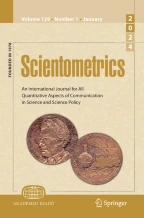1981Accesses
67Citations
3 Altmetric
Abstract
The twoJournal Citation Reports of the Science Citation Index 2004 and the Social Science Citation Index 2004 were combined in order to analyze and map journals and specialties at the edges and in the overlap between the two databases. For journals which belong to the overlap (e.g.,Scientometrics), the merger mainly enriches our insight into the structure which can be obtained from the two databases separately; but in the case of scientific journals which are more marginal in either database, the combination can provide a new perspective on the position and function of these journals (e.g.,Environment and Planning B — Planning and Design). The combined database additionally enables us to map citation environments in terms of the various specialties comprehensively. Using the vector-space model, visualizations are provided for specialties that are parts of the overlap (information science, science & technology studies). On the basis of the resulting visualizations, “betweenness” — a measure from social network analysis — is suggested as an indicator for measuring the interdisciplinarity of journals.
Article PDF
Similar content being viewed by others
Explore related subjects
Discover the latest articles, books and news in related subjects, suggested using machine learning.Avoid common mistakes on your manuscript.
References
Ahlgren, P., Jarneving, B., Rousseau, R. (2003), Requirement for a cocitation similarity measure, with special reference to Pearson’s correlation coefficient.Journal of the American Society for Information Science and Technology, 54(6): 550–560.
Batagelj, V., Mrvar, A. (2003), Pajek — Analysis and visualization of large networks. In:M. Jünger, P. Mutzel (Eds),Graph Drawing Software, Springer, Berlin, pp. 77–103.
De Nooy, W., Mrvar, A., Batagelj, V. (2005),Exploratory Social Network Analysis with Pajek. Cambridge University Press, Cambridge, NY.
Freeman, L. C. (1978/1979), Centrality in social networks. Conceptual clarification.Social Networks, 1: 215–239.
Hanneman, R. A., Riddle, M. (2005),Introduction to Social Network Methods. University of California, Riverside, CA; athttp://faculty.ucr.edu/:_hanneman
Jones, W. P., Furnas, G. W. (1987), Pictures of relevance: A geometric analysis of similarity measures.Journal of the American Society for Information Science, 36(6): 420–442.
Kamada, T., Kawai, S. (1989), An algorithm for drawing general undirected graphs.Information Processing Letters, 31(1): 7–15.
Leydesdorff, L. (1989), The relations between qualitative theory and scientometric methods in S&T studies. Introduction to the topical issue.Scientometrics, 15: 333–347.
Leydesdorff, L. (1993), The impact of citation behaviour on citation structure. In:A. F. J. van Raan, R. E. de Bruin, H. F. Moed, A. J. Nederhof, R. W. J. Tijssen (Eds),Science and Technology in a Policy Context, DSWO/ Leiden University Press, Leiden, pp. 289–300.
Leydesdorff, L. (2007), Visualization of the citation impact environments of scientific journals: An online mapping exercise.Journal of the American Society of Information Science and Technology, 58(1): 207–222.
Leydesdorff, L. (forthcoming), Environment and Planning B as a journal: The interdisciplinarity of its environment and the citation impact.Environment and Planning B — Planning and Design.
Leydesdorff, L., Cozzens, S. E. (1993), The delineation of specialties in terms of journals using the dynamic journal set of the Science Citation Index.Scientometrics, 26: 133–154.
Leydesdorff, L., Van Den Besselaar, P. (1997), Scientometrics and communication theory: Towards theoretically informed indicators.Scientometrics, 38: 155–174.
Mrvar, A., Bagatelj, V. (s.d.),Network Analysis Using Pajek; athttp://vlado.fmf.uni-lj.si/pub/networks/pajek/doc/pajekman.htm Retrieved May 25, 2006.
Salton, G., McGill, M. J. (1983),Introduction to Modern Information Retrieval. McGraw-Hill, Auckland, etc.
Shriffin, R. M., Börner, K. (2004), Mapping knowledge domains.Proceedings of the National Academy of the United States of America, 101(Suppl. 1) (April 6): 5183–5310.
Van Den Besselaar, P. (2001), The cognitive and the social structure of science & technology studies.Scientometrics, 51: 441–460.
Wasserman, S., Faust, K. (1994),Social Network Analysis: Methods and Applications. Cambridge University Press, New York.
Author information
Authors and Affiliations
Amsterdam School of Communications Research (ASCoR), University of Amsterdam, Kloveniersburgwel 48, 1012 CX, Amsterdam, The Netherlands
Loet Leydesdorff
- Loet Leydesdorff
Search author on:PubMed Google Scholar
Corresponding author
Correspondence toLoet Leydesdorff.
Rights and permissions
Open Access This is an open access article distributed under the terms of the Creative Commons Attribution Noncommercial License (https://creativecommons.org/licenses/by-nc/2.0 ), which permits any noncommercial use, distribution, and reproduction in any medium, provided the original author(s) and source are credited.
About this article
Cite this article
Leydesdorff, L. Mapping interdisciplinarity at the interfaces between the Science Citation Index and the Social Science Citation Index.Scientometrics71, 391–405 (2007). https://doi.org/10.1007/s11192-007-1694-z
Received:
Issue date:
Share this article
Anyone you share the following link with will be able to read this content:
Sorry, a shareable link is not currently available for this article.
Provided by the Springer Nature SharedIt content-sharing initiative



